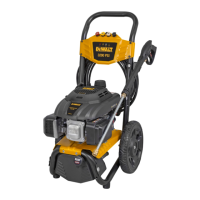8
ENGLISH
How To Use Spray Wand
The nozzles for the spray wand are stored in the nozzle holder on
the panel assembly. Colors on the panel identify nozzle location
and spray pattern. Refer to the following chart to choose the correct
nozzle for the job to beperformed. NOTE: Some models may not
include all of the nozzles shown in the chart.
Changing Nozzles on Spray Wand (Fig. G)
DANGER: Risk of fluid injection. Do not direct
discharge stream toward persons, unprotected skin,
eyes or any pets or animals. Serious injury willoccur.
WARNING: Flying objects could cause risk of serious
injury. Do not attempt to change nozzles while
pressure washer is running. Turn engine off before
changingnozzles.
1. Pull quick-connect coupler
5
back and insert nozzle
11
.
2. Release quick-connect coupler and twist nozzle to make
sure it is secure incoupler.
WARNING: Flying object could cause risk of serious
injury. Ensure nozzle is completely inserted in quick-
connect socket and quick-connect collar is fully
engaged (forward) before squeezing guntrigger.
Nozzle
Colour
Spray Pattern Uses Surfaces*
Red
0˚
powerful pinpoint
for very intense
cleaning
metal or concrete;
DO NOT use on
wood
Yellow
15˚
intense cleaning of
small areas
metal, concrete or
wood
Green
25
˚
intense cleaning of
larger areas
metal, concrete or
wood
White
40
˚
covers wide areas of
cleaning
metal, concrete,
wood or vinyl
Black
low pressure
applies chemical/
cleaning soaps
metal, concrete,
wood or vinyl
* NOTICE: The high pressure spray from your pressure washer
is capable of causing damage to surfaces such as wood, glass,
automobile paint, auto striping and trim, delicate objects
such as flowers and shrubs. Before spraying, check the item to
be cleaned to assure yourself that it is strong enough to resist
damage from the force ofspray.
How to Apply Chemicals/Cleaning Solvents
(Fig. A)
Applying chemicals or cleaning solvents is a low pressure
operation. NOTE: Use only soaps and chemicals designed for
pressure washer use. Do not usebleach.
To Apply Chemicals:
1. Remove the cap from the detergent tank
12
and fill the
detergent tank with cleaning solvent. Replace cap on
deteregenttank. NOTE: For every 38 liters of water pumped
38 liters of chemical/cleaning solution will beused.
2. Install the black low pressure nozzle into the quick connect
fitting of the spray wand. See How To Use Spray Wand
paragraph in thissection. NOTE: After squeezing the trigger
it will take approximately 5 seconds for the detergent
toappear.
3. After use of chemicals, fill the detergent tank with clean
water and draw clean water through chemical injection
system to rinse system thoroughly. If chemicals remain in
the pump it could be damaged. Pumps damaged due to
chemical residue will not be covered underwarranty.
NOTE: Chemicals and soaps will not siphon if the black soap
nozzle is not installed on the spraywand.
Starting (Fig. A, F, H–K)
WARNING: To reduce the risk of injury, read the pressure
washer instruction manual and the engine instruction
manual before starting pressurewasher.
DANGER: Risk of fluid injection and laceration. When
using the high pressure setting, DO NOT allow the high
pressure spray to come in contact with unprotected skin,
eyes, or with any pets, animals, or people. Serious injury
willoccur.
• Your washer operates at fluid pressures and velocities
high enough to penetrate human and animal flesh,
which could result in amputation or other serious
injury. Leaks caused by loose fittings or worn or
damaged hoses can result in injection injuries. DO
NOT TREAT FLUID INJECTION AS A SIMPLE CUT! See a
physician immediately!
DANGER: Carbon Monoxide. Using an engine
indoors can kill. Engine exhaust contains high levels
of carbon monoxide (CO), a poisonous gas you
cannot see or smell. You may be breathing CO even if
you do not smell engineexhaust.
• Breathing exhaust fumes will cause serious injury or
death! Engine exhaust contains carbon monoxide, an
odorless and deadlygas.
• Operate pressure washer in a well-ventilated area.
Avoid enclosed areas such as garages, basements,etc.
• Never operate unit in or near a location occupied by
humans oranimals.
WARNING: Risk of fire, asphyxiation and burning. Never
fill fuel tank when engine is running or hot. Do not smoke
when filling fueltank.

